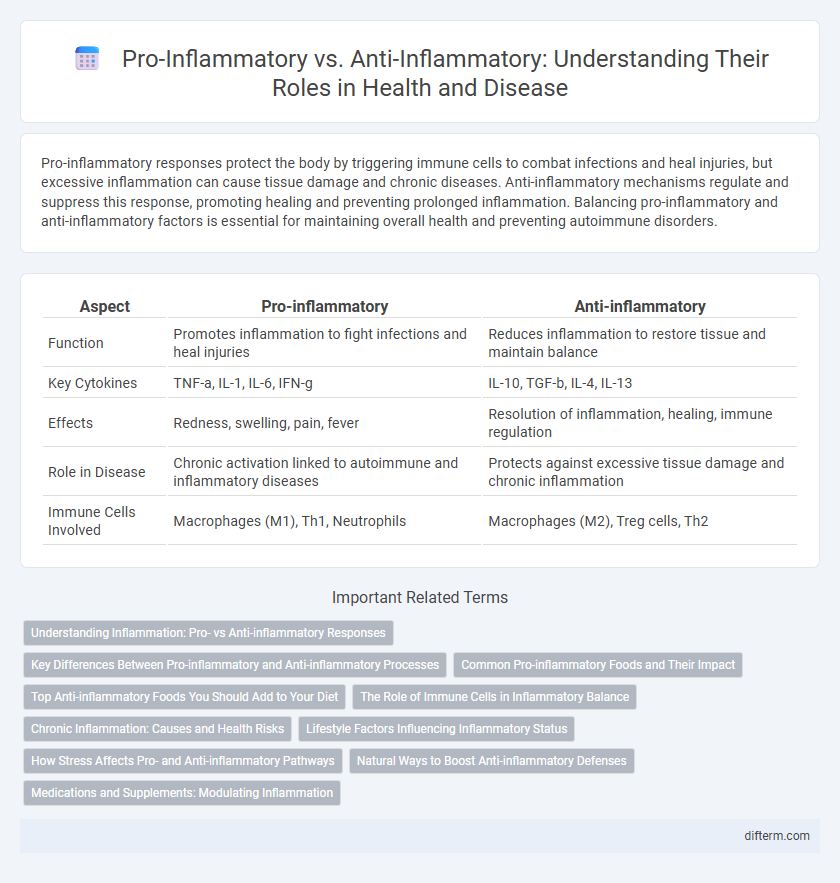Pro-inflammatory responses protect the body by triggering immune cells to combat infections and heal injuries, but excessive inflammation can cause tissue damage and chronic diseases. Anti-inflammatory mechanisms regulate and suppress this response, promoting healing and preventing prolonged inflammation. Balancing pro-inflammatory and anti-inflammatory factors is essential for maintaining overall health and preventing autoimmune disorders.
Table of Comparison
| Aspect | Pro-inflammatory | Anti-inflammatory |
|---|---|---|
| Function | Promotes inflammation to fight infections and heal injuries | Reduces inflammation to restore tissue and maintain balance |
| Key Cytokines | TNF-a, IL-1, IL-6, IFN-g | IL-10, TGF-b, IL-4, IL-13 |
| Effects | Redness, swelling, pain, fever | Resolution of inflammation, healing, immune regulation |
| Role in Disease | Chronic activation linked to autoimmune and inflammatory diseases | Protects against excessive tissue damage and chronic inflammation |
| Immune Cells Involved | Macrophages (M1), Th1, Neutrophils | Macrophages (M2), Treg cells, Th2 |
Understanding Inflammation: Pro- vs Anti-inflammatory Responses
Pro-inflammatory responses involve the release of cytokines such as TNF-alpha and IL-6, which activate immune cells to combat pathogens but may cause tissue damage if uncontrolled. Anti-inflammatory responses, mediated by molecules like IL-10 and transforming growth factor-beta (TGF-b), help resolve inflammation and promote tissue repair. Balancing pro-inflammatory and anti-inflammatory mechanisms is essential for maintaining immune homeostasis and preventing chronic inflammatory diseases.
Key Differences Between Pro-inflammatory and Anti-inflammatory Processes
Pro-inflammatory processes trigger immune responses by releasing cytokines such as IL-1, TNF-alpha, and IL-6 to combat infections and initiate tissue repair, often leading to redness, swelling, and pain. Anti-inflammatory processes, mediated by cytokines like IL-10 and TGF-beta, work to suppress excessive immune reactions and promote healing by reducing inflammation and restoring tissue homeostasis. The balance between pro-inflammatory and anti-inflammatory mechanisms is crucial for preventing chronic inflammation and maintaining immune system equilibrium.
Common Pro-inflammatory Foods and Their Impact
Common pro-inflammatory foods such as refined sugars, trans fats, and processed meats increase the production of cytokines and oxidative stress, promoting chronic inflammation linked to cardiovascular diseases and diabetes. High consumption of these foods disrupts gut microbiota balance, exacerbating systemic inflammation and impairing immune response. Reducing intake of pro-inflammatory foods is crucial for managing inflammation-related conditions and improving overall metabolic health.
Top Anti-inflammatory Foods You Should Add to Your Diet
Incorporating top anti-inflammatory foods such as turmeric, berries, fatty fish like salmon, and leafy greens can significantly reduce chronic inflammation linked to diseases like arthritis and heart conditions. These foods are rich in antioxidants, omega-3 fatty acids, and polyphenols, which help neutralize harmful free radicals and modulate the body's inflammatory response. Regular consumption supports immune health, lowers inflammation markers like C-reactive protein, and promotes overall well-being.
The Role of Immune Cells in Inflammatory Balance
Immune cells like macrophages and T-cells critically regulate the inflammatory balance by shifting between pro-inflammatory and anti-inflammatory states to maintain tissue homeostasis. Pro-inflammatory immune cells release cytokines such as TNF-alpha and IL-6, which amplify inflammation and combat pathogens, whereas anti-inflammatory cells secrete IL-10 and TGF-beta to resolve inflammation and promote healing. Dysregulation in this immune cell activity can lead to chronic inflammatory diseases such as rheumatoid arthritis and inflammatory bowel disease.
Chronic Inflammation: Causes and Health Risks
Chronic inflammation arises from persistent triggers like unresolved infections, autoimmune disorders, and prolonged exposure to irritants such as smoking or pollution, causing an imbalance between pro-inflammatory cytokines (e.g., TNF-alpha, IL-6) and anti-inflammatory agents (e.g., IL-10, TGF-beta). This sustained inflammatory state contributes to tissue damage, insulin resistance, and the progression of diseases including cardiovascular disease, type 2 diabetes, and certain cancers. Effective management involves targeting molecular pathways to restore immune balance and reduce the risk of long-term complications.
Lifestyle Factors Influencing Inflammatory Status
Diet rich in processed foods and sugars promotes pro-inflammatory cytokines, increasing chronic inflammation risk, while whole foods abundant in antioxidants and omega-3 fatty acids enhance anti-inflammatory pathways. Regular physical activity regulates immune response, reducing pro-inflammatory markers such as IL-6 and TNF-alpha, thereby improving systemic inflammation status. Stress management and adequate sleep duration are critical lifestyle factors that modulate cortisol levels and decrease chronic inflammation, supporting overall health and disease prevention.
How Stress Affects Pro- and Anti-inflammatory Pathways
Chronic stress activates the hypothalamic-pituitary-adrenal (HPA) axis, resulting in elevated cortisol levels that initially suppress anti-inflammatory cytokines but can eventually lead to glucocorticoid resistance and heightened pro-inflammatory responses. Persistent stress enhances production of pro-inflammatory cytokines such as IL-6 and TNF-a, contributing to systemic inflammation and increased risk for chronic diseases like cardiovascular disease and autoimmune disorders. Modulation of the inflammatory balance through stress management techniques supports the restoration of anti-inflammatory pathways, promoting immune homeostasis and reducing inflammation-driven pathology.
Natural Ways to Boost Anti-inflammatory Defenses
Consuming foods rich in omega-3 fatty acids, such as salmon and flaxseeds, enhances the body's anti-inflammatory defenses by reducing pro-inflammatory cytokines. Incorporating antioxidants from colorful fruits and vegetables like berries and spinach supports cellular health and modulates inflammation pathways naturally. Regular physical activity and adequate sleep further regulate immune responses, promoting a balanced inflammatory state crucial for reducing chronic disease risk.
Medications and Supplements: Modulating Inflammation
Medications such as nonsteroidal anti-inflammatory drugs (NSAIDs) and corticosteroids are widely used to suppress pro-inflammatory pathways by inhibiting cyclooxygenase enzymes and cytokine production, reducing inflammation and pain. Supplements like omega-3 fatty acids, curcumin, and probiotics promote anti-inflammatory effects by modulating immune response and lowering levels of pro-inflammatory markers such as C-reactive protein and tumor necrosis factor-alpha. Targeted use of these medications and supplements optimizes inflammation management in chronic conditions like arthritis and inflammatory bowel disease.
Pro-inflammatory vs Anti-inflammatory Infographic

 difterm.com
difterm.com